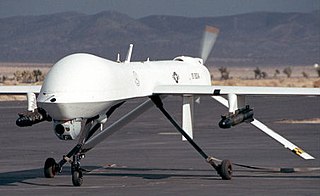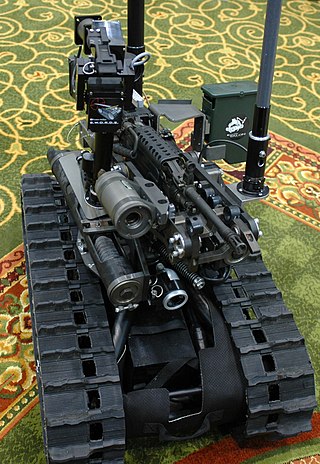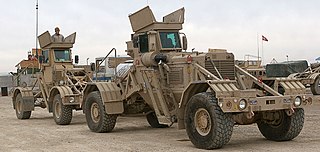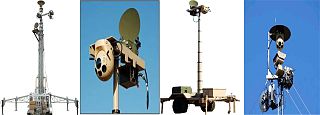
A land mine, or landmine, is an explosive weapon concealed under or camouflaged on the ground, and designed to destroy or disable enemy targets, ranging from combatants to vehicles and tanks, as they pass over or near it.

The Claymore mine is a directional anti-personnel mine developed for the United States Armed Forces. Its inventor, Norman MacLeod, named the mine after a large medieval Scottish sword. Unlike a conventional land mine, the Claymore may be command-detonated, and is directional, shooting a wide pattern of metal balls into a kill zone. The Claymore can also be activated by a booby-trap tripwire firing system for use in area denial operations.

Bomb disposal is an explosives engineering profession using the process by which hazardous explosive devices are disabled or otherwise rendered safe. Bomb disposal is an all-encompassing term to describe the separate, but interrelated functions in the military fields of explosive ordnance disposal (EOD) and improvised explosive device disposal (IEDD), and the public safety roles of public safety bomb disposal (PSBD) and the bomb squad.

Military robots are autonomous robots or remote-controlled mobile robots designed for military applications, from transport to search & rescue and attack.

The Israeli Combat Engineering Corps is the combat engineering forces of the Israel Defense Forces.

An unmanned ground vehicle (UGV) is a vehicle that operates while in contact with the ground and without an onboard human presence. UGVs can be used for many applications where it may be inconvenient, dangerous, or impossible to have a human operator present. Generally, the vehicle will have a set of sensors to observe the environment, and will either autonomously make decisions about its behavior or pass the information to a human operator at a different location who will control the vehicle through teleoperation.

United States Navy Explosive Ordnance Disposal technicians render safe all types of ordnance, including improvised, chemical, biological, and nuclear. They perform land and underwater location, identification, render-safe, and recovery of foreign and domestic ordnance. They conduct demolition of hazardous munitions, pyrotechnics, and retrograde explosives using detonation and burning techniques. They forward deploy and fully integrate with the various Combatant Commanders, Special Operations Forces (SOF), and various warfare units within the Navy, Marine Corps, Air Force and Army. They are also called upon to support military and civilian law enforcement agencies, as well as the Secret Service.

The Foster-Miller TALON is a remotely operated vehicle, and it is a small, tracked military robot designed for missions ranging from reconnaissance to combat. It is made by the American robotics company QinetiQ-NA, a subsidiary of QinetiQ.

U.S. Coast Guard Port Security Units are Deployable Specialized Forces organized for sustained expeditionary security and anti-terrorism. They provide Anti-Terrorism Force Protection (ATFP) missions, which include harbor and port defense, protection of High Value Assets (HVAs), expeditionary security, Sea Lines of Communications (SLOCs), special missions. and coastal surveillance. PSUs are expeditionary units that conduct OCONUS missions in support of a requesting regional combatant commander. PSUs usually operate under the direction of the Coast Guard's Pacific Area (PACAREA) command but are unique in that they are the only Coast Guard units that can be quickly requested by the Department of Defense.
The Rapid Equipping Force (REF) was a United States Army organization headquartered in Fort Belvoir, Virginia. The organization was charged with quickly providing Army units deployed globally with innovative government off-the-shelf and commercially available solutions that address urgent requirements within 180 days or less. The REF was able to do this through unique authorities and by maintaining a presence near the point of need. REF personnel were positioned in Iraq, Afghanistan, and Kuwait and mobile laboratories are available for quick solutions. Additionally, the REF empowered the Army at a grassroots level, enabling individual soldiers to communicate needs directly through simple request forms.

The Buffalo is a wheeled mine resistant ambush protected (MRAP) armored military vehicle built by Force Protection, Inc., a division of General Dynamics. It is the largest vehicle in Force Protection's line-up, followed by the Cougar MRAP and the Ocelot light protected patrol vehicle (LPPV).

The Cougar is a mine-resistant ambush-protected (MRAP) and infantry mobility vehicle structured to be resistant to landmines and improvised munitions.
The Iraqi Armed Forces are the military forces of the Republic of Iraq. They consist of the Iraqi Army, the Iraqi Air Force, and the Iraqi Navy. Along with these three primary service branches, there exists the Iraqi Counter Terrorism Service and the Popular Mobilization Forces. The President of Iraq acts as the supreme commander as outlined by the constitution.

The Husky VMMD is a configurable counter-IED MRAP vehicle, developed by South African-based DCD Protected Mobility and American C-IED company Critical Solutions International. Designed for use in route clearance and de-mining operations, the Husky is equipped with technologies to help detect explosives and minimise blast damage.

Special reconnaissance (SR) is conducted by small units, such as a recon team, made up of highly trained military personnel, usually from special forces units and/or military intelligence organizations. Special reconnaissance teams operate behind enemy lines, avoiding direct combat and detection by the enemy. As a role, SR is distinct from commando operations, but both are often carried out by the same units. The SR role frequently includes covert direction of airstrikes and indirect fire, in areas deep behind enemy lines, placement of remotely monitored sensors, and preparations for other special forces. Like other special forces, SR units may also carry out direct action and unconventional warfare, including guerrilla operations.
4/73 (Sphinx) Special Observation Post Battery Royal Artillery is a Surveillance and Target Acquisition (STA) unit of the British Army. It fields the British Army with long-range STA Patrols which provide specialist surveillance, reconnaissance and joint fires in high-threat environments. It is part of 5th Regiment Royal Artillery and is based at Catterick Garrison in North Yorkshire.
The Modular Advanced Armed Robotic System (MAARS) is a robot that is being developed by Qinetiq. A member of the TALON family, it will be the successor to the armed SWORDS robot. It has a different, larger chassis than the SWORDS robot, so has little physically in common with the SWORDS and TALON

Counter-IED equipment are created primarily for military and law enforcement. They are used for standoff detection of explosives and explosive precursor components and defeating the Improvised Explosive Devices (IEDs) devices themselves as part of a broader counter-terrorism, counter-insurgency, or law enforcement effort.

The Ground-Based Operational Surveillance System, (G-BOSS) created by Raytheon Integrated Defense Systems, is a trailer-mounted tower with mounted surveillance systems. It was integrated with the command operations center (COC) used primarily by the United States Marine Corps during the War in Afghanistan (2001-2021) and the War in Iraq. The G-BOSS is used primarily for force protection, checkpoint security, route reconnaissance, patrol over watch, improvised explosive devices emplacement detection, intelligence gathering, and personnel/vehicle identification.

The Israeli Ground Forces are the ground forces of the Israel Defense Forces (IDF). The commander is the General Officer Commanding with the rank of Major General, the Mazi, subordinate to the Chief of General Staff.
















